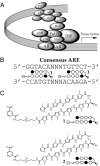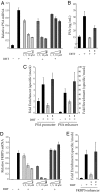Suppression of androgen receptor-mediated gene expression by a sequence-specific DNA-binding polyamide
- PMID: 17566103
- PMCID: PMC1965528
- DOI: 10.1073/pnas.0704217104
Suppression of androgen receptor-mediated gene expression by a sequence-specific DNA-binding polyamide
Abstract
Androgen receptor (AR) is essential for the growth and progression of prostate cancer in both hormone-sensitive and hormone-refractory disease. A DNA-binding polyamide that targets the consensus androgen response element binds the prostate-specific antigen (PSA) promoter androgen response element, inhibits androgen-induced expression of PSA and several other AR-regulated genes in cultured prostate cancer cells, and reduces AR occupancy at the PSA promoter and enhancer. Down-regulation of PSA by this polyamide was comparable to that produced by the synthetic antiandrogen bicalutamide (Casodex) at the same concentration. Genome-wide expression analysis reveals that a similar number of transcripts are affected by treatment with the polyamide and with bicalutamide. Direct inhibition of the AR-DNA interface by sequence-specific DNA binding small molecules could offer an alternative approach to antagonizing AR activity.
Conflict of interest statement
The authors declare no conflict of interest.
Figures




Similar articles
-
Ligand-independent activation of the androgen receptor by the differentiation agent butyrate in human prostate cancer cells.Cancer Res. 2000 Oct 15;60(20):5825-31. Cancer Res. 2000. PMID: 11059779
-
Regulation of FGF8 expression by the androgen receptor in human prostate cancer.Oncogene. 2002 Aug 1;21(33):5069-80. doi: 10.1038/sj.onc.1205663. Oncogene. 2002. PMID: 12140757
-
Phosphorylation/dephosphorylation of androgen receptor as a determinant of androgen agonistic or antagonistic activity.Biochem Biophys Res Commun. 1999 May 27;259(1):21-8. doi: 10.1006/bbrc.1999.0655. Biochem Biophys Res Commun. 1999. PMID: 10334909
-
A novel androgen receptor-binding element modulates Cdc6 transcription in prostate cancer cells during cell-cycle progression.Nucleic Acids Res. 2009 Aug;37(14):4826-38. doi: 10.1093/nar/gkp510. Epub 2009 Jun 11. Nucleic Acids Res. 2009. PMID: 19520769 Free PMC article.
-
Prostate cancer: molecular biology of early progression to androgen independence.Endocr Relat Cancer. 1999 Dec;6(4):487-502. doi: 10.1677/erc.0.0060487. Endocr Relat Cancer. 1999. PMID: 10730903 Review.
Cited by
-
Modulation of topoisomerase IIα expression and chemosensitivity through targeted inhibition of NF-Y:DNA binding by a diamino p-anisyl-benzimidazole (Hx) polyamide.Biochim Biophys Acta Gene Regul Mech. 2017 May;1860(5):617-629. doi: 10.1016/j.bbagrm.2016.10.005. Epub 2016 Oct 24. Biochim Biophys Acta Gene Regul Mech. 2017. PMID: 27750031 Free PMC article.
-
Characterization and solubilization of pyrrole-imidazole polyamide aggregates.J Med Chem. 2012 Jun 14;55(11):5425-32. doi: 10.1021/jm300380a. Epub 2012 May 24. J Med Chem. 2012. PMID: 22607187 Free PMC article.
-
RNA polymerase II senses obstruction in the DNA minor groove via a conserved sensor motif.Proc Natl Acad Sci U S A. 2016 Nov 1;113(44):12426-12431. doi: 10.1073/pnas.1612745113. Epub 2016 Oct 17. Proc Natl Acad Sci U S A. 2016. PMID: 27791148 Free PMC article.
-
Repression of the transcriptional activity of ERRα with sequence-specific DNA-binding polyamides.Med Chem Res. 2020 Apr;29(4):607-616. doi: 10.1007/s00044-019-02493-4. Epub 2020 Feb 26. Med Chem Res. 2020. PMID: 34552311 Free PMC article.
-
An HRE-Binding Py-Im Polyamide Impairs Hypoxic Signaling in Tumors.Mol Cancer Ther. 2016 Apr;15(4):608-17. doi: 10.1158/1535-7163.MCT-15-0719. Epub 2015 Dec 30. Mol Cancer Ther. 2016. PMID: 26719577 Free PMC article.
References
-
- Tsai MJ, Omalley BW. Annu Rev Biochem. 1994;63:451–486. - PubMed
-
- Tyagi RK, Lavrovsky Y, Ahn SC, Song CS, Chatterjee B, Roy AK. Mol Endocrinol. 2000;14:1162–1174. - PubMed
-
- Roche PJ, Hoare SA, Parker MG. Mol Endocrinol. 1992;6:2229–2235. - PubMed
-
- Cleutjens KB, van der Korput HA, van Eekelen CC, van Rooij HC, Faber PW, Trapman J. Mol Endocrinol. 1997;11:148–161. - PubMed
-
- Cleutjens KB, van Eekelen CC, van der Korput HA, Brinkmann AO, Trapman J. J Biol Chem. 1996;271:6379–6388. - PubMed
Publication types
MeSH terms
Substances
Associated data
- Actions
Grants and funding
LinkOut - more resources
Full Text Sources
Other Literature Sources
Medical
Molecular Biology Databases
Research Materials
Miscellaneous

